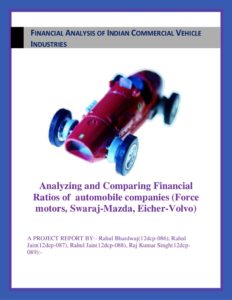
Since the calculated value of t two tail at at.05 level of significance is less than table value of t, alternate hypothesis is rejected and null hypothesis is accepted that there is no significant difference between current ratio of Maruti Suzuki and Tata Motors.
6. CONCLUSION
On the basis of above analysis and interpretation in can be concluded that Maruti Suzuki and Tata Motors are maintaining current ratio at an average of 1.48:1 and 0.54:1 respectively during the study period of 2010-11 to 2014-15, which is less than, standard current ratio of 2:1. A current ratio of more than 2:1 is considered to be good and a current ratio of less than 2:1 is considered to be risky from the view point of short term solvency. Current ratio elucidates the relationship between current assets and current liabilities of a firm. If the proportions of current assets are twice or more than twice the current liabilities it reflects that a firm is having sufficient working capital to pay its current liabilities on time. If current assets are less than twice the current liabilities it reveals that a firm is having shortage of working capital. Shortage of working capital may increase the difficulty of firm to meet its short term liabilities on time or whenever they become due.
Since, both the companies are maintaining current ratio of less than 2:1 it means that both the companies i.e. Maruti Suzuki and Tata Motors are maintaining current ratio less than standard for the study period. As far as short term solvency is concerned, it can be concluded that Maruti Suzuki is having an edge over Tata Motors. Both the companies are expected to increase their current ratio. In order to increase current ratio both the companies are expected to either increase their current assets or decrease their short term liabilities.
Leave a Reply Cancel reply
Categories
- Animal28
- Apps4
- Art70
- Auto50
- Business175
- Career1
- Education114
- Faith62
- Family186
- Fashion35
- Food67
- Gadgets16
- Gaming13
- Health139
- Hobby134
- Holidays26
- Home98
- Legal12
- Marketing40
- Money96
- News30
- News130
- Other Stories4
- Pet1
- Photography14
- Poem23
- Science28
- SkyPip3
- Social Network75
- Society159
- Software23
- Technology127
- Travel69







Leave a Reply